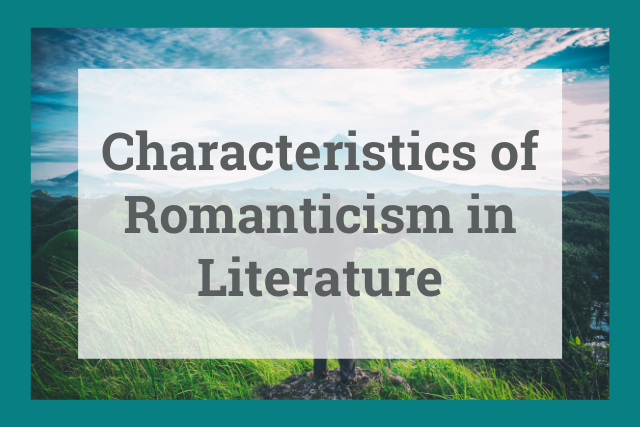
The Romantic Era is one of the key movements in the history of English literature. It includes many of the literary works that we still read and love today, from Mary Shelley's Frankenstein to Herman Melville's Moby Dick.
This article will define the Romantic period and describe ten of the most important characteristics of Romanticism in English literature.
What is the Romantic Movement?
The term “Romantic literature” might sound like it has something to do with romance, but it actually refers to something else entirely.
The word "romantic" can be used to describe love stories in any culture or time period, while the word "Romantic" with a capital "R" describes a literary movement from the 18th and 19th centuries. You could sit down at your desk right now and write romantic poetry, but you couldn't write Romantic poetry without the help of a time machine.
The Romantic period, also known as Romanticism, was an intellectual, artistic, and literary movement that took place in Europe and America around 1780-1850.
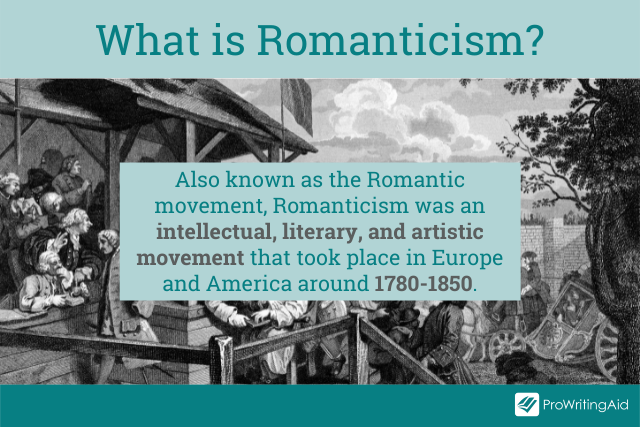
European Romanticism began as a reaction to the ways in which the Industrial Revolution and the Enlightenment had transformed society.
The Enlightenment had prioritized reason and rationality over emotion and creativity. The Industrial Revolution had urbanized England. Technology was booming, science was accelerating, and cities were becoming increasingly crowded.
As a result of these changes, many people felt like humanity was losing its relationship with the natural world and the sublime.
Along came the Romanticists: a group of artists, writers, and intellectuals who celebrated nature, emotion, and the spiritual. They criticized the way society had changed and glorified the past in their work.
One of the most powerful things about literature is that it holds up a mirror to the society that it was written in. Europe and America changed drastically in the late-18th century, and the Romantic Era was a reaction to the societal issues of the time.
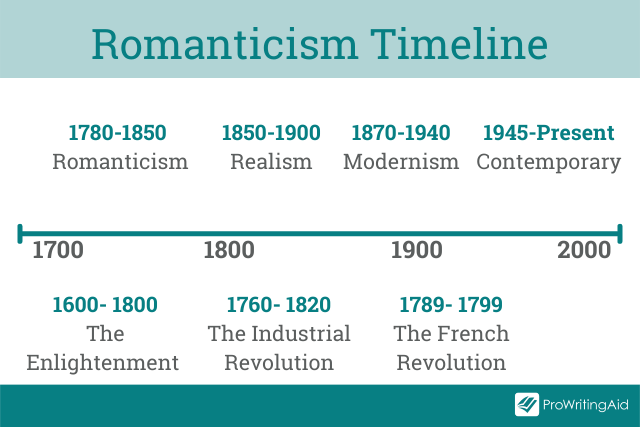
Who Were the Most Influential Writers of the Romantic Period?
Important Romantic poets include William Wordsworth, Walt Whitman, Henry Wadsworth Longfellow, Henry David Thoreau, William Blake, John Keats, Samuel Taylor Coleridge, Emily Dickinson, and Percy Bysshe Shelley.
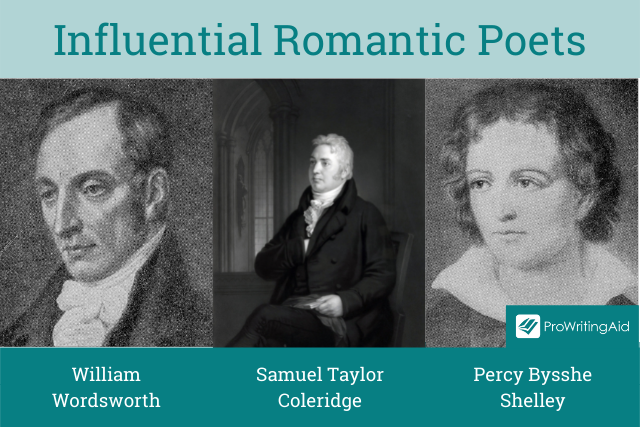
Important fiction writers from the Romantic era include Emily Brontë (Wuthering Heights), Charlotte Brontë (Jane Eyre), Mary Shelley (Frankenstein), Herman Melville (Moby Dick), James Fenimore Cooper (The Last of the Mohicans), and Nathaniel Hawthorne (The Scarlet Letter).
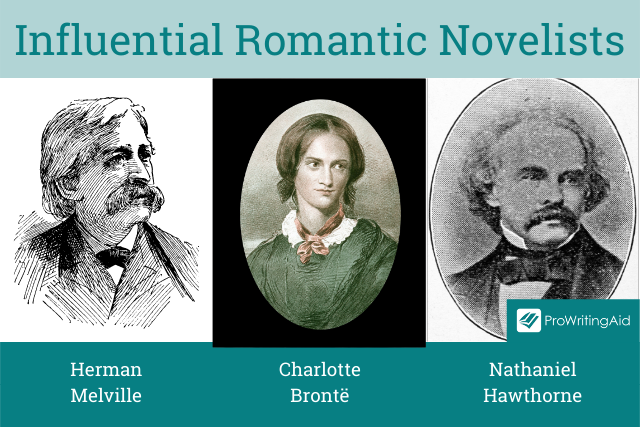
What Are the Characteristics of Romanticism?
Central features of the Romantic era include:
- Emotion and passion
- The critique of progress
- A return to the past
- An awe of nature
- The idealization of women
- The purity of childhood
- The search for subjective truth
- The celebration of the individual
- A break from convention
- Spirituality and the occult
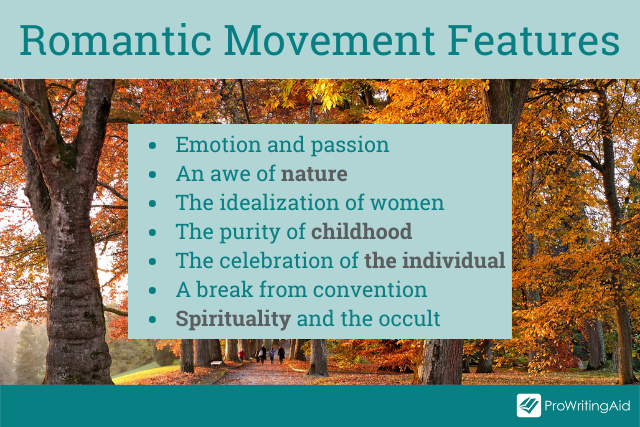
Let’s look at each of these characteristics in more detail and analyze some examples from Romantic poetry and prose.
Characteristic 1: Emotion and Passion
The Romanticists were deeply in touch with their feelings. Emotion was one of the most crucial characteristics of the Romantic period.
Wordsworth said that poetry began as “the spontaneous overflow of powerful feeling: it takes its origin from emotion recollected in tranquility.” This statement perfectly captures the way that many Romanticists saw emotion as a driving force for art.
Romanticists cared about emotions such as fear, awe, and horror. In stories written by Romantic writers, characters often focus on the more sentimental sides of the story, including their inner struggles, dreams, and passions.
Similarly, many characters in Romantic literature fell in love, instead of marrying out of convenience. One notable example is Wuthering Heights by Emily Brontë. When Heathcliff finds out that Catherine is dead, he utters:
“Be with me always—take any form—drive me mad. Only do not leave me in this abyss, where I cannot find you! Oh, God! It is unutterable! I cannot live without my life! I cannot live without my soul!”
Heathcliff’s passion is the type of powerful emotion that was characteristic of Romantic literature—and an example of a book in which Romanticism and romance actually overlap.
Characteristic 2: The Critique of Progress
Romanticists viewed urbanity and industrialization in a largely negative light. Many Romantic authors understood the importance of progress, but criticized the way it impacted the common people.
In England, the Industrial Revolution had created a large working class that worked in dangerous and grueling conditions. The chasm between the rich and the poor was widening every day.
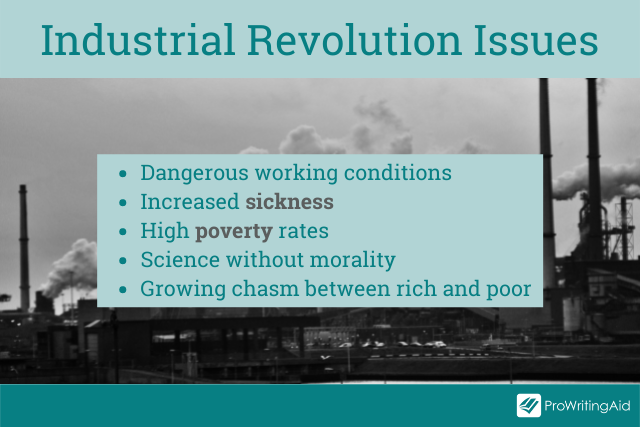
Many Romantic writers depicted the ugly side of urbanization and commercialism and used their writing to argue for social change in England.
Mary Shelley’s famous novel Frankenstein (1818) is an example of a Romantic novel that depicted the dangers of technology without emotion.
In the story, Victor Frankenstein is so obsessed with the pursuit of knowledge that he forgets to question his own ethics and ends up creating a monster. At one point, the monster even exclaims: "Cursed, cursed creator! Why did I live? Why, in that instant, did I not extinguish the spark of existence which you had so wantonly bestowed?"
Characteristic 3: A Return to the Past
Related to their critique of progress is the fact that Romanticists were fascinated with the past and resurrected it in various forms. They used their writing to remind everyone of what the past had to offer and how far society had moved away from the good old days.
Many Romanticists glorified the Middle Ages and revived elements of literature—such as knights in shining armor and damsels in distress—that were perceived as more medieval.
Similarly, Romantic writers were interested in ruins and old artifacts of history. Many Romanticists traveled to Greece and Italy to glean inspiration from Greek and Roman ruins.
Characteristic 4: An Awe of Nature
The Romanticists saw nature as a source of beauty and truth. Much of Romantic literature focuses on nature as something sublime.
There are countless Romantic poets who wrote lyrical ballads about everything from birds and flowers to mountains and clouds.
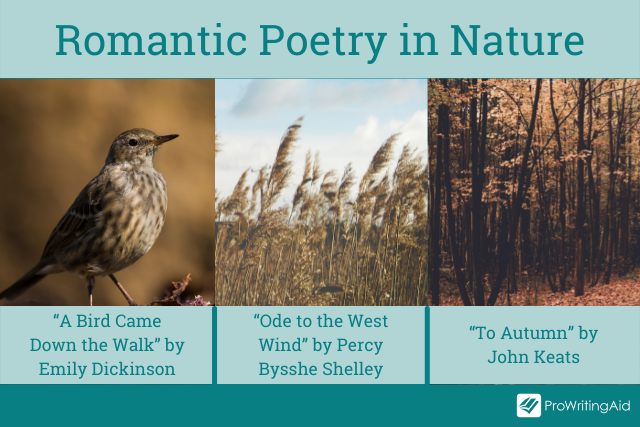
Take the poem “I Wandered Lonely as a Cloud” (1807) by William Wordsworth, one of the most famous early Romantic poets. Here’s the first verse:
I wandered lonely as a Cloud
That floats on high o'er vales and Hills,
When all at once I saw a crowd,
A host, of golden Daffodils;
Beside the Lake, beneath the trees,
Fluttering and dancing in the breeze.
In this poem, he exalts the beauty of the daffodils he sees, painting a vivid image of the nature around him. He uses simple visual language to describe the sublime. In fact, ProWritingAid's Sensory check detects that 100% of the sensory language that Wordsworth uses is visual.
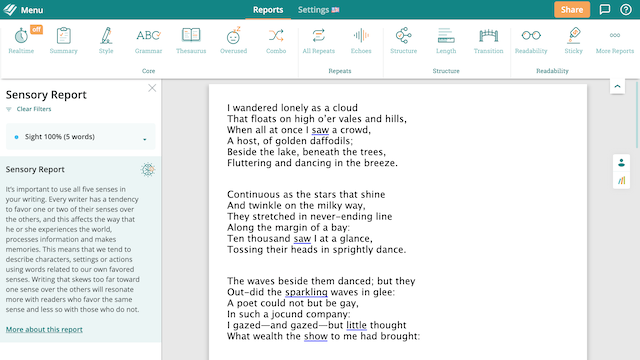
Characteristic 5: The Idealization of Women
In the Romantic era, women were seen as innocent, pure creatures who should be admired and respected.
Many Romantic poets and novelists centered their narratives around celebrating the purity and beauty of a woman.
Unfortunately, this idealization meant that the Romantic Movement typically saw women as objects for male admiration rather than as people with their own dreams and ambitions. Female writers such as Jane Austen, Mary Shelley, and the Brontë sisters had to publish under male pseudonyms because of these attitudes.
One example of the idealization of women is Edgar Allan Poe’s poem “Annabel Lee” (1849):
For the moon never beams, without bringing me dreams
Of the beautiful Annabel Lee;
And the stars never rise, but I feel the bright eyes
Of the beautiful Annabel Lee;
And so, all the night-tide, I lie down by the side
Of my darling—my darling—my life and my bride,
In her sepulchre there by the sea—
In her tomb by the sounding sea.
Here, Poe puts Annabel on a pedestal as he describes how beautiful she was before her death.
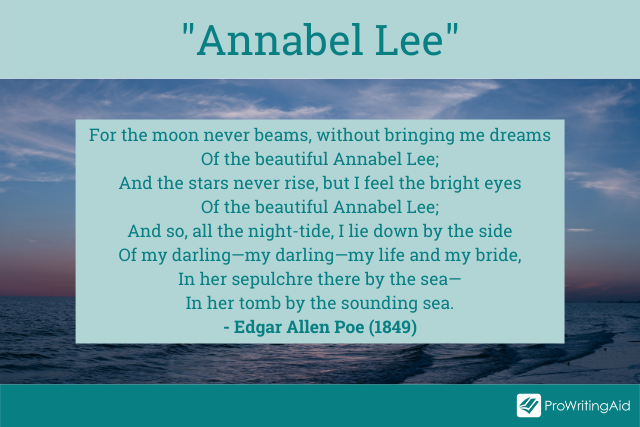
Characteristic 6: The Purity of Childhood
Romanticists believed that children should be allowed to have a pure, happy childhood.
At the time, many children were forced to work in factories or as chimney sweeps, which was dangerous and grueling work for which they were paid extremely low wages. Romantic writers and poets depicted a different kind of childhood—a happy one full of play instead of work.
This is an excerpt from T.S. Arthur’s short story “An Angel in Disguise” (1851): "The sweetness of that sick child, looking ever to her in love, patience, and gratitude, was as honey to her soul, and she carried her in her heart as well as in her arms, a precious burden."
Here, Arthur describes the way a child’s “love, patience, and gratitude” brings happiness to a family.
Characteristic 7: The Search for Subjective Truth
Romanticists believed that truth could be discovered in nature and imagination. They shunned the objective truths of science in favor of the more subjective truths of art.
Self-expression was seen as the way to achieve absolute truth, which was more permanent and more divine than anything discovered with the rational mind. They questioned the notion that there could be any single truth.
The poem “Ode on a Grecian Urn” (1820) by John Keats is addressed to a marble urn of ancient Greece. The final line of the poem reads: “Beauty is truth, truth beauty, that is all.”
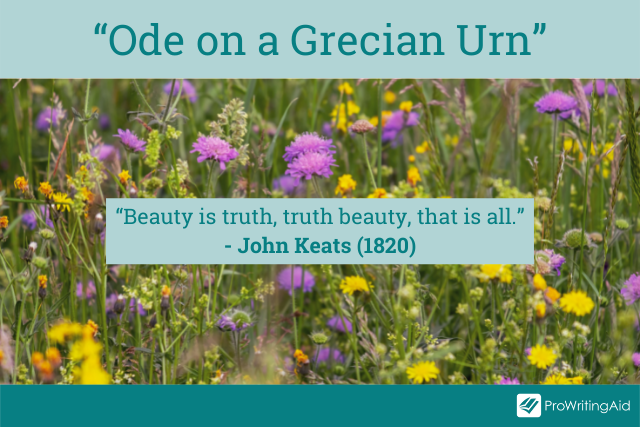
Characteristic 8: The Celebration of the Individual
Many Romanticists saw themselves as self-reliant, independent individuals who stood apart from the rest of society, and some even chose to lead largely isolated, solitary lives.
Ralph Waldo Emerson wrote an essay called Self-Reliance in 1841, describing the importance of determining your own path and relying on your own resources.
One well-known quote from the essay reads: "To be yourself in a world that is constantly trying to make you something else is the greatest accomplishment.”
Characteristic 9: A Break From Convention
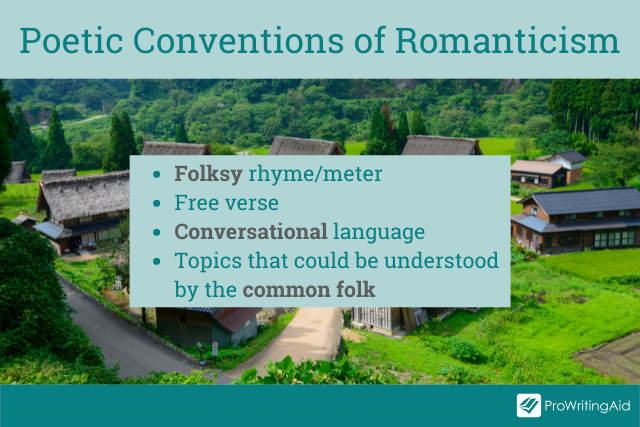
Romanticists were rebels at heart. Many of them were attracted to movements related to individualism and freedom from oppression. The French Revolution, and other movements toward democracy, inspired many Romantic philosophers.
Similarly, Romantic writers believed that individuals should be allowed to decide what and how they wanted to write, instead of following formal rules and classical conventions.
In general, Romanticism believed that the content of literature should come from the writer’s imagination, with minimal outside input. Being derivative, or copying work that had come before, was seen as the worst sin.
Many Romantic poets, such as William Wordsworth and Samuel Taylor Coleridge, broke the conventions of the time. They wrote poetry that used the language of ordinary speech and felt like a normal conversation, instead of following the more sophisticated rules that other poets had followed before.
Walt Whitman took this a step farther by writing poetry in free verse, without any rhyme or meter. This is common in poetry today, but at the time, it was a groundbreaking choice that shook off previous rules.
Here’s the first verse of Walt Whitman’s famous poem “Song of Myself” (1855):
I celebrate myself, and sing myself,
And what I assume you shall assume,
For every atom belonging to me as good belongs to you.
Notice how he doesn’t conform to any type of rhyme scheme or meter. Instead, he writes a poem that feels almost like a conversation.
Characteristic 10: Spirituality and the Occult
As we’ve already discussed, Romanticists were interested in the infinite and the divine. As a result, Romanticism began to include occult and supernatural elements.
Many Romantic poems and stories involve some aspect of the mystical or the “gothic.”
Edgar Allan Poe is a commonly cited example of a Romantic writer who used spiritual and supernatural elements in his stories and poems. This is a verse from his poem “Spirits of the Dead” (1827), which depicts a divine mystery:
The breeze—the breath of God—is still—
And the mist upon the hill,
Shadowy—shadowy—yet unbroken,
Is a symbol and a token—
How it hangs upon the trees,
A mystery of mysteries!
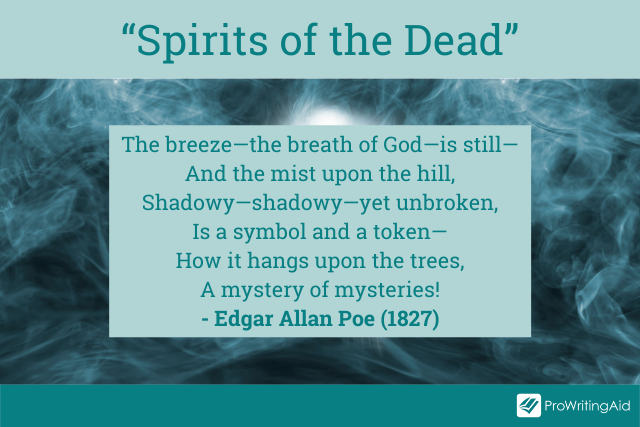
How Has Romantic Literature Affected Our Literature Today?
Romanticism as a literary movement has had tremendous influence on literature today.
The most direct legacy Romantic writers left behind is their body of work, which remains popular even now. Novels and poems from the Romantic period are still taught in most English literature classes.
More importantly, however, Romantic writers also broke conventions and elevated new themes in ways that changed the field for contemporary writers.
Before the Romantic Movement, most English literature centered around essays and studying the Classics, with a focus on rationality and truth. There were very specific conventions that well-respected writers were expected to follow.
Literary Romanticism shifted the focus of literature toward emotions and imagination. Any time you read a poem without a rhyme scheme, or a novel that focuses on the protagonist's emotions and passions, you're reading a descendant of the Romantic Era.
These are ten of the most important characteristics of Romanticism, a movement that continues to influence the literature we read today.
What are your favorite Romantic poems and stories? Let us know in the comments.
Writing romance? Join us for our FREE online summit
October 11–15: Romance Writers’ Week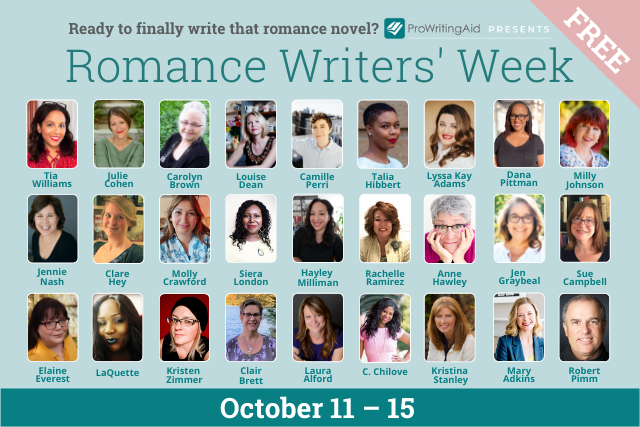
ProWritingAid will be hosting our first ever Romance Writers’ Week in October. Join hundreds of other romance writers to learn what makes a romance novel swoon-worthy. Whether you’re writing contemporary, paranormal, historical, or speculative romance (or something in between), you’ll find practical, actionable sessions to help you plan, write, and market your romance story.
Learn from bestselling authors like Tia Williams, Talia Hibbert, Louise Dean, and Carolyn Brown, as well as romance writing experts from Pages & Platforms, Simon & Schuster, Harlequin, Romance Writers of America, and more.

